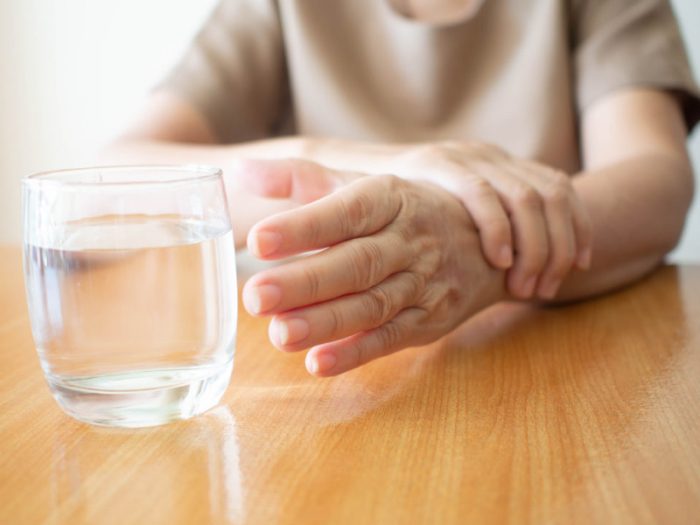Medical Compass: Slowing Parkinson’s disease progression
Much new research focuses on dietary approaches
By David Dunaief

Parkinson’s disease is a neurodegenerative disease, most often associated with a movement disorder, or tremors. According to the Parkinson’s Foundation, roughly 60,000 Americans are diagnosed with Parkinson’s disease (PD) each year, and approximately one million Americans are living with PD (1).
Patients with PD suffer from a collection of symptoms caused by the breakdown of brain neurons. In medicine, we know the most common symptoms by the mnemonic TRAP: tremors while resting, rigidity, akinesia/bradykinesia (inability/difficulty to move or slow movements) and postural instability or balance issues. It can also result in a masked face, one that has become expressionless, and potentially dementia.
There are several different subtypes of PD; the diffuse/malignant phenotype has the highest propensity toward cognitive decline (2).
There’s a lot we still don’t know about the causes of PD; however, risk factors may include head trauma, reduced vitamin D, milk intake, well water, being overweight, high levels of dietary iron, and migraine with aura in middle age.
The part of the brain most affected is the basal ganglia, and the prime culprit is dopamine deficiency that occurs in this brain region (3). Adding back dopamine has been the mainstay of medical treatment, but eventually the neurons themselves break down, and the medication becomes less effective. Is there hope? Yes, in the form of medications and deep brain stimulatory surgery, but also with lifestyle modifications. Lifestyle factors include iron, vitamin D and CoQ10. The research, unfortunately, is not conclusive, though it is intriguing.
Reducing iron in the brain
This heavy metal is potentially harmful for neurodegenerative diseases such as Alzheimer’s disease, macular degeneration, multiple sclerosis and, yes, Parkinson’s disease. The problem is that this heavy metal can cause oxidative damage.
In a small, yet well-designed, randomized controlled trial (RCT), researchers used a chelator to remove iron from the substantia nigra, a specific part of the brain where iron breakdown may be dysfunctional. An iron chelator is a drug that removes the iron. Here, deferiprone (DFP) was used at a modest dose of 30 mg/kg/d (4). This drug was mostly well-tolerated.
The chelator reduced the risk of disease progression significantly on the Unified Parkinson Disease Rating Scale (UPDRS) during the 12-month study. Participants who were treated sooner had lower levels of iron compared to a group that used the chelator six months later. A specialized MRI was used to measure levels of iron in the brain.
The iron chelator does not affect, nor should it affect, systemic levels of iron, only those in the brain specifically focused on the substantia nigra region. The chelator may work by preventing degradation of the dopamine-containing neurons. It also may be recommended to consume foods that contain less iron.
Does CoQ10 slow progression?
When we typically think of using CoQ10, a coenzyme found in over-the-counter supplements, it is to compensate for depletion from statin drugs or due to heart failure. Typical doses range from 100 to 300 mg. However, there is evidence that CoQ10 may be beneficial in Parkinson’s at much higher doses.
In an RCT, results showed that those given 1,200 mg of CoQ10 daily reduced the progression of the disease significantly based on UPDRS changes, compared to the placebo group (5). Other doses of 300 and 600 mg showed trends toward benefit, but were not significant. This was a 16-month trial in a small population of 80 patients. Unfortunately, results for other CoQ10 studies have been mixed. In this study, CoQ10 was well-tolerated at even the highest dose. Thus, there may be no downside to trying CoQ10 in those with PD.
Is Vitamin D part of the puzzle?
In a prospective study, results show that vitamin D levels measured in the highest quartile reduced the risk of developing Parkinson’s disease by 65 percent, compared to the lowest quartile (6). This is quite impressive, especially since the highest quartile patients had vitamin D levels that were what we would qualify as insufficient, with blood levels of 20 ng/ml, while those in the lowest quartile had deficient blood levels of 10 ng/ml or less. There were over 3,000 patients involved in this study with an age range of 50 to 79.
While many times we are deficient in vitamin D and have a disease, replacing the vitamin does nothing to help the disease. Here, it does. Vitamin D may play dual roles of both reducing the risk of Parkinson’s disease and slowing its progression.
In an RCT, results showed that 1,200 IU of vitamin D taken daily may have reduced the progression of Parkinson’s disease significantly on the UPDRS compared to a placebo over a 12-month duration (7). Also, this amount of vitamin D increased the blood levels by almost two times from 22.5 to 41.7 ng/ml. There were 121 patients involved in this study with a mean age of 72.
So, what have we learned? Though medication with dopamine agonists is the gold standard for the treatment of Parkinson’s disease, lifestyle modifications can have a significant impact on both prevention and treatment of this disease. Each lifestyle change in isolation may have modest effects, but cumulatively their impact could be significant. The most exciting part is that lifestyle modifications have the potential to slow the disease progression and thus have a protective effect.
References:
(1) parkinson.org. (2) JAMA Neurol. 2015;72:863-873. (3) uptodate.com. (4) Antioxid Redox Signal. 2014;10;21(2):195-210. (5) Arch Neurol. 2002;59(10):1541-1550. (6) Arch Neurol. 2010;67(7):808-811. (7) Am J Clin Nutr. 2013;97(5):1004-1013.
Dr. David Dunaief is a speaker, author and local lifestyle medicine physician focusing on the integration of medicine, nutrition, fitness and stress management. For further information, visit www.medicalcompassmd.com.







